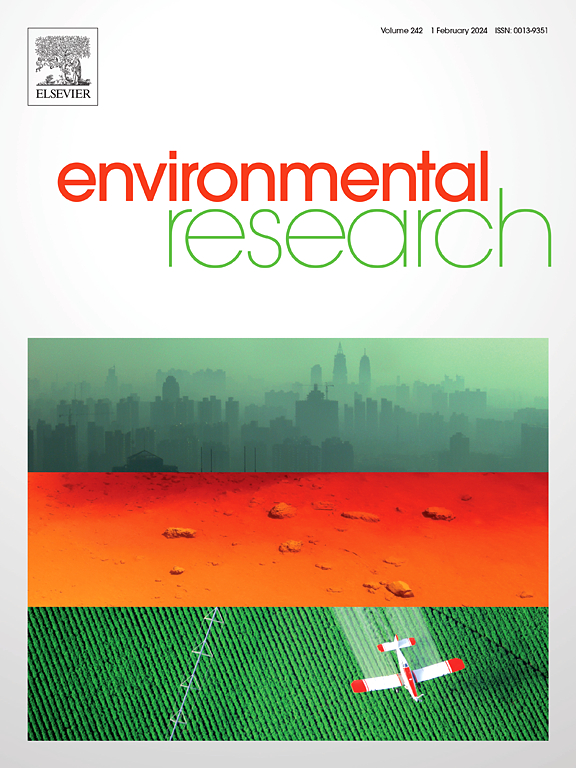Surrounding residential greenness and mental health: Findings from the French CONSTANCES cohort
IF 7.7
2区 环境科学与生态学
Q1 ENVIRONMENTAL SCIENCES
引用次数: 0
Abstract
This cross-sectional study assessed the association between surrounding greenness and two mental health outcomes according to degree of urbanization in the French CONSTANCES cohort. We included 114,717 participants. Depression in 2018 was evaluated by Center for Epidemiologic Studies Depression Scale (CES-D, from 0 to 60), and psychological distress in 2019 by General Health Questionnaire-12 (GHQ-12, from 0 to 12). Residential surrounding greenness was quantified by the mean of normalized difference vegetation index (NDVI) within 300m circular buffer around residential address. Adjusted negative binomial models were performed to assess the cross-sectional association between a 0.1 increase in NDVI at 300m and each outcome, separately in rural, peri-urban, urban and Paris areas. Stratified analyses by age and sex, and causal mediation models evaluating the role of physical activity were conducted. In 2018, the median age was 48.5, with 54.5 % being women. A 0.1 unit increase of NDVI was associated to lower depressive symptoms in peri-urban areas (incidence rate ratio (IRR) = 0.92; 95 % CI: 0.84–1.00) but higher in Paris (1.21; 1.06–1.38), and no associations were found in urban or rural areas. A 0.1 unit NDVI increase was associated to lower GHQ-12 score in peri-urban (IRR: 0.77; 95 % CI: 0.64–0.93) and urban areas (IRR: 0.79; 95 % CI: 0.65–0.97), with stronger effect size for middle-aged adults in urban areas and men in peri-urban areas. No associations were found in rural or Paris areas. Physical activity showed no mediation role. Surrounding greenness was associated with better mental health in peri-urban and urban but not in rural areas, possibly due to differences in types and uses of greenspaces.

周边住宅绿化与心理健康:来自法国康斯坦斯队列的研究结果
这项横断面研究评估了法国康斯坦斯队列中根据城市化程度的周围绿化与两种心理健康结果之间的关系。我们纳入了114,717名参与者。2018年的抑郁症由流行病学研究中心抑郁量表(CES-D,从0到60)评估,2019年的心理困扰由一般健康问卷-12 (GHQ-12,从0到12)评估。采用归一化植被指数(NDVI)均值量化住区周边绿化率。采用调整后的负二项模型,分别在农村、城郊、城市和巴黎地区评估300米NDVI增加0.1与每个结果之间的横断面关联。通过年龄和性别分层分析,以及评估身体活动作用的因果中介模型进行了分析。2018年,中位年龄为48.5岁,其中54.5%为女性。在城郊地区,NDVI每增加0.1个单位,抑郁症状就会降低(发病率比(IRR) = 0.92;95% CI: 0.84-1.00),但在巴黎更高(1.21;1.06-1.38),在城市和农村地区均未发现相关性。每增加0.1单位NDVI,城郊GHQ-12评分就会降低(IRR: 0.77;95% CI: 0.64-0.93)和城市地区(IRR: 0.79;95% CI: 0.65-0.97),对城市地区的中年人和城郊地区的男性有更强的效应量。在农村或巴黎地区没有发现关联。体力活动没有中介作用。在城郊和城市地区,周围的绿色与更好的心理健康有关,但在农村地区则不然,这可能是由于绿色空间的类型和用途不同。
本文章由计算机程序翻译,如有差异,请以英文原文为准。
求助全文
约1分钟内获得全文
求助全文
来源期刊

Environmental Research
环境科学-公共卫生、环境卫生与职业卫生
CiteScore
12.60
自引率
8.40%
发文量
2480
审稿时长
4.7 months
期刊介绍:
The Environmental Research journal presents a broad range of interdisciplinary research, focused on addressing worldwide environmental concerns and featuring innovative findings. Our publication strives to explore relevant anthropogenic issues across various environmental sectors, showcasing practical applications in real-life settings.
 求助内容:
求助内容: 应助结果提醒方式:
应助结果提醒方式:


